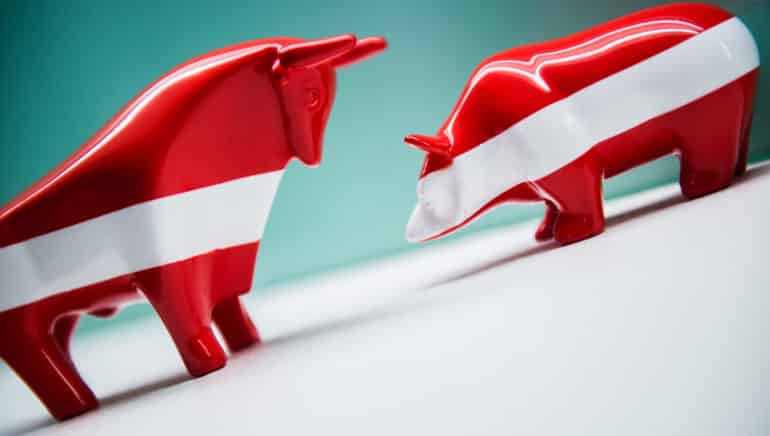Author: Dieter Kerschbaum, Communications Specialist Austria
On 31 May the Vienna Stock Exchange Award will be celebrated and awarded to the winner. The day is dedicated to the financial centre of Austria, and the award is accompanied by numerous other events that are geared towards drawing investors’ attention to the domestic stock exchange. Erste Asset Management is one of the biggest investors at the Vienna stock exchange. In the past five years, the Vienna stock exchange has seen a clear upward trend. We spoke about the reasons for the steep upswing, possible risks, and the future perspective with Bernhard Ruttenstorfer, manager of the equity fund ESPA STOCK VIENNA:
How have Austrian equities fared in recent times?

Bernhard Ruttenstorfer, Senior Fonds Manager for Austrian Bond Funds
The ATX, i.e. the main index of the Vienna stock exchange, has gained 21.6% in the year to date (as of 23 May 2017; source: Bloomberg). The year-on-year gain is 44.4% (as of 23 May 2017; source: Bloomberg), and over the past five years the index has increased by 65.8% as of 23 May 2017. However, looking back one has to bear in mind that we have gone through several ups and downs (see the performance chart for ESPA STOCK VIENNA). This means that investors should be relaxed and patient. In return, they may reap the benefits in the long run.

The performance is calculated in accordance with the OeKB method. It already includes the management fee. However, the illustration is net of the one-off load of up to 3,00 %, which falls due at the time of purchase, and of other fees that reduce the return as well as of the individual account and deposit fees. Past performance is not a reliable indicator of the future performance of a fund.
Interestingly, the index embarked on a rise right after the Brexit vote in the UK, i.e. at a time when one would have expected turbulences due to the unclear future of the UK. Why did the stock exchange not match those expectations?
According to a stock market adage, “political markets have short legs”. Investors were focusing on the economic development in spite of the eventful news flow. We can see that the fundamental data of the global economy are improving, especially in Europe, where inflation is approaching the target band of the European Central Bank of 2%. The interest rates at the long end (i.e. long-running government bonds) have already increased slightly. Most recently the two important Austrian economic research institutes have revised their economic growth forecast up: in Q1 2017, the industrial cycle continued to pick up momentum. Domestic companies invested again in their production capacities. Total value added increased in the construction industry as well. GDP growth was 0.6% (source: www.wifo.ac.at).
What effects did the positive economic environment have on the results among ATX companies?
A significant number of companies have realigned their strategies in recent years. They are now reaping the fruits of those realignments. For example, Lenzing used to be primarily a viscose producer, but in the past two years it has turned into a specialty producer, which the stock exchange appreciates. Or another example, OMV has moved its focus from the North Sea to production sites with lower costs, e.g. Russia or Libya. Other companies such as for example Palfinger, RHI, and Wienerberger are market leaders in certain segments. It is therefore good to see that about 60% (source: Bloomberg) of the reporting companies of the ATX have exceeded analyst estimates in terms of earnings and sales in Q1 2017. In addition, the positive trend of dividend distributions continues. Therefore, the recent development at the stock exchange is supported by fundamentals. In spite of the increase in share prices, company valuations at the stock exchange have remained attractive (see chart below). At the end of April, the price/earnings ratio of the ATX amounted to about 14x (source: Bloomberg).

Past performance is not a reliable indicator of the future performance of an index
The Vienna stock exchange has been regarded as fringe market by important investors. Do you have reason to believe that this could change?
The Vienna stock exchange has of course benefited from the rise in global share prices. But the ATX has clearly outperformed the German equity index (DAX) for example; on a year-on-year basis by 18.4% (as of 23 May 2017; same basis, dividends included). International investors are currently rediscovering the market along the lines of “I buy into the potential of Eastern Europe by investing in a country in the heart of Europe”. The relative low liquidity is a stumbling block, but those in positions of responsibility are aware of that and are working on improvements.
Will the snap elections on 15 October influence the performance?
No, the elections of the National Council have no influence on the current development of the stock exchange. It is the overarching events such as development of the international economy, inflation, interest rates, and especially the business side (i.e. microeconomic data) of the corporate sector that will impact the Vienna stock exchange.
Investing in Austrian equities: ESPA STOCK VIENNA
A fund that invests exclusively in Austrian equities. The fund management team follows a bottom-up investment approach (i.e. an investment strategy of equity investment fund managers where the first step is to analyse the growth potential of certain companies. After that, the opportunities of the sectors and the overall market are put under scrutiny. Source: FAZ).
For more information on the benefits for investors and the risks that have to be borne in mind, please visit our overview.


